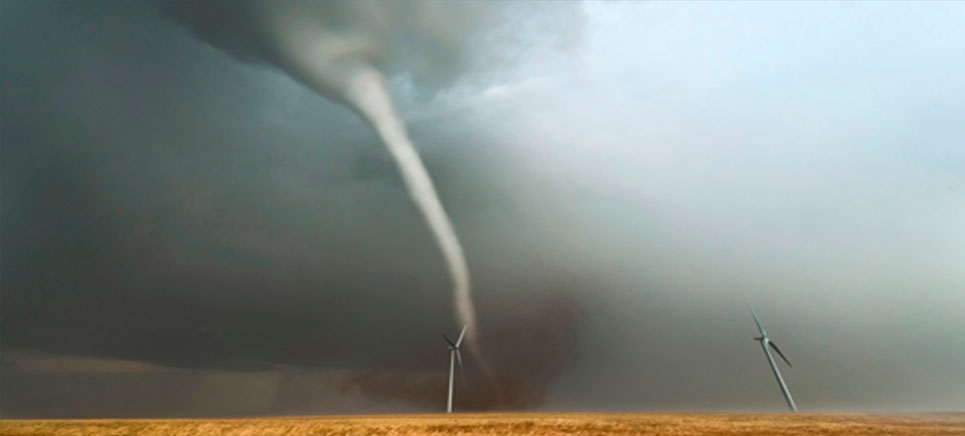Tornadoes are one of the highly destructive natural phenomena like hurricane, earthquakes and avalanche. They are a devastating combination of wind and power that can knock down houses, flip cars or even lift lightweight objects to 10,000 feet in the air. They are not only deadly but also unpredictable, making it difficult for meteorologists to study.
What is a Tornado?
A tornado is a violently rotating column of air developed within a convective cloud and in contact with the ground. This small-diameter column of air touching the ground is often in contact with a cumulonimbus cloud, and in rare cases with the base of a cumulus cloud. It is also known by the name of twisters or whirlwind. Although often seen in the shape of a condensation funnel with a cloud of rotating debris and dust beneath it, tornadoes come in various shapes and sizes.
While most tornadoes have a wind speed of less than 180 km/h, extreme tornadoes can attain a wind speed of more than 480 km/h. The violent column of air suddenly appears descending from the cloud and hits the ground, mostly in the shape of a funnel. This giant funnel moves forward with vigorous force roaring like the sound of a freight train. It is so violent that it tears down everything that it finds in the way.

Formation of a Tornado
Not all storms take the form of a tornado. There are several factors that together result in the formation of a tornado and the cumulonimbus clouds that are associated with the formation of a tornado. An abundant amount of low-level moisture is necessary for the formation of a thunderstorm. The moist air needs to be carried aloft in the form of a cumulous cloud which will be transformed into a cumulonimbus or the thunderstorm cloud if the atmosphere is unstable. Finally, tornadoes require strong winds at all levels. In a tornado, winds blow counterclockwise in the Northern Hemisphere and clockwise in the Southern Hemisphere.
With all the contributing factors in place, this is how a thunderstorm is actually formed:
- When direct sunlight heats the ground, small pockets of air are heated more than the surrounding areas.
- This warmer air begins to rise and form cumulus clouds. The cumulous clouds keep rising until they transform into a cumulonimbus cloud. (Unstable atmosphere is a must for a cumulous cloud to transform into a cumulonimbus cloud).
- If the above process happens in an area with winds increasing strongly with increasing altitude, a horizontal spin is created in the atmosphere.
- The updraught begins to lift a section of the horizontally spinning wind and tilt the vortex into a vertical position. Thunderstorms that exhibit a persistent behavior are termed as a supercell and a supercell becomes the heart of a tornado.
- Due to the much-reduced pressure within the tornado vortex, a funnel-shaped cloud is formed. When the tip of this violently rotating funnel touches the ground it is termed as a tornado.
Where do Tornadoes happen?
Tornadoes occur in many parts of the world including areas of Asia, Australia, Africa, Europe and South America. But, the great plains of the central United States have the ideal environment for the formation of severe thunderstorms and tornadoes. This is the reason plains of the central United States are termed as Tornado Alley. Warm moist air moving north from the Gulf of Mexico meets the cold dry air moving south from Canada creating an ideal condition for the initiation of a thunderstorm. While tornadoes can occur at any time of the year, May and June are peak season. About 1,200 tornadoes hit the US every year.
Frequently Asked Question
Q. Can Tornadoes be predicted?
A. No! It is nearly impossible to predict the occurrence of a tornado.
Q. Where did the most extreme tornado occur?
A. The most extreme tornado recorded to date is said to be the tri-state tornado which happened on March 18, 1925. The tornado was spread through parts of Missouri, Illinois and Indiana. The tornado went on for 219 miles killing 695 people and injuring 2027 more.
Q. What is a Fujita Scale?
A. The Fujita Scale, commonly called as F-Scale, is a scale used to rate tornadoes. The rating of the scale is primarily based on the damages inflicted by the tornado on vegetation and human-built structure.
Use the citation below to add this article to your bibliography
"Tornadoes: Definition, Formation, Occurrences and Prediction." Dashamlav.com. Web. 22 October 2024. <https://dashamlav.com/tornadoes-definition-formation-occurrences-prediction/>
Dashamlav.com, "Tornadoes: Definition, Formation, Occurrences and Prediction." Accessed 22 October 2024. https://dashamlav.com/tornadoes-definition-formation-occurrences-prediction/
"Tornadoes: Definition, Formation, Occurrences and Prediction." (n.d.). Dashamlav.com. Retrieved 22 October 2024 from https://dashamlav.com/tornadoes-definition-formation-occurrences-prediction/
